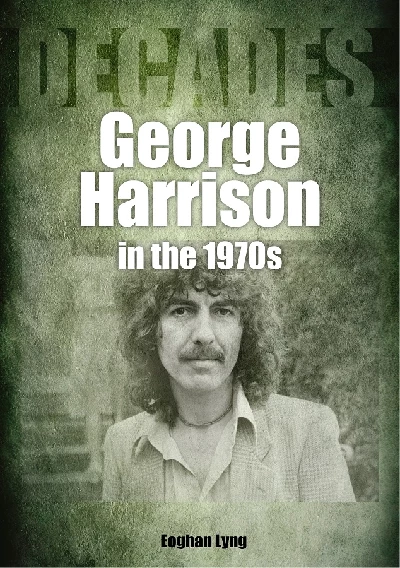published: 8 /
9 /
2022

George Harrison surpassed expectations as a songwriter after initially being regarded as "the quiet Beatle". In her 'Raging Pages' book column Lisa Torem discovers that Eoghan Lyng's new book explores many facets of the British songwriter's career.
Article
George Harrison was often described by the press during his stint with the “Fab Four” as “the quiet Beatle,” but his creative output, dry wit, songwriting and expert guitar playing during that era, and after, belies that modest descriptor. Fortunately, Eoghan Lyng, an Irish author and Beatles fan, sets the record straight in ‘George Harrison in the 1970s’ for the Sonicbond Publishing ‘Decades’ series.
Lyng cites Harrison work that stood beside, and often surpassed, other album tracks, such as the Abbey Road classic, ‘Something.’ This romantic ballad was even lauded by the likes of Frank Sinatra, a singer who was often dismissive of a latter generation’s tastes. Industry giant George Martin, responsible for major Beatles’ arrangements, also had a jaw-dropping reaction. That said, Lyng points out: “Producer George Martin was stunned by the song’s maturity and embellished the piece with an exquisite string arrangement.”
Lyng stresses Harrison’s accomplishments in his post-Beatles career. When Phil Spector agreed to record Harrison on All Things Must Pass, “a triple album,” the American producer was amazed at the volume of songs Harrison had already stockpiled. The irony, of course, was that Harrison had only been asked to contribute a few songs on a series of Beatles albums in his earlier career. At this point, however, it appeared that his musical input was infinite.
Harrison’s strongly spiritual nature deeply affected his musical output, too. When he accompanied his colleagues to meet the Maharishi Mahesh Yogi in India, he developed a deep love for Indian music and meditation. Harrison included sitar and tabla in some of his most fascinating compositions, but the instruments revealed much about Harrison’s state-of-mind.
Commenting on the follow-up studio album to ‘All Things Must Pass’, “Material World’ demonstrated a slower, more detached persona aching for meaning in a world that seemed determined to lose it,” Lyng states in the section 1973: When He Was Fab.
Interestingly, Harrison remained continually open to roots-based American music. That said, the catchy ‘My Sweet Lord’ was inspired by a famous gospel tune. Although this song dragged the songwriter into the mud legally, when he was accused of imitating The Chiffons’ ‘He’s So Fine,’ it revealed another approach to pop creativity. Musically, the guitarist developed and honed a signature sound based on his slide guitar skills.
Lyng juxtaposes Harrison’s relationships with the other former Beatles, as well as with innovators who assisted with musical ideas and arrangements, such as Peter Frampton, Bob Dylan, Eric Clapton and Jeff Lynne.
Lyng doesn’t rally behind every album or celebrate every conquest, but he is quick to point out the purpose behind his research. He finds ‘Thirty-Three & 1/3’ lacking, for example, as a whole, “…it’s strangely pedestrian for a man who was determined to stand out at all junctures.” Still, ‘This Song’ and ‘It’s What You Value’ merit his compliments. Musically, Harrison breaks out of his comfort zone—he dove into the synth for ‘Dear One.’
There is a great deal to discover about Harrison’s lengthy and fruitful career in this compact work. If you want to know what made George Harrison tick, this is the book.
Band Links:-
https://www.georgeharrison.com/
https://www.facebook.com/georgeharriso
https://twitter.com/georgeharrison
https://en.wikipedia.org/wiki/George_H
https://www.instagram.com/georgeharris
Play in YouTube:-